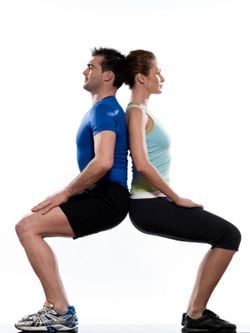 Try this simple posture "reality check" the next time you are standing in front of a full-length mirror:
Try this simple posture "reality check" the next time you are standing in front of a full-length mirror:
- Are your knees and ankles straight (i.e., not angled inward or outward)?
- Are your shoulders and hips level?
- As you stand sideways, does your lower back have a natural curve in it?
- Do the spaces between your arms and sides seem equal?
- Is your chin level or parallel to the floor?
- Is your head straight?
Proper posture is one of the best preventive measures you can take to ensure a healthy spine. Good posture means maintaining your spine in a neutral position. This means standing or sitting so that your spine keeps its three natural curves—the small hollow at the base of the neck, a small roundness at the middle back, and a small hollow in the lower back.
Proper posture is the result of good musculoskeletal balance, which helps protect the joints in your spine from undue stress and guards against injury and deformity. It requires diligence and awareness on your part. Most of us need to gently prod ourselves mentally to ensure we are walking and sitting correctly.
Poor posture can result from regularly carrying excessive weights, or hunching over when working at a computer or watching television. It also has been linked to chronic headaches, shoulder pain, and TMJ dysfunction. It also can lead to such problems as: fatigue (from over-taxed muscles supporting a misaligned spine); muscle aches in your neck, back, arms, and legs; and stiff, painful joints (which may eventually lead to conditions such as degenerative osteoarthritis.)
Sometimes, poor posture is something that cannot be helped. For example, people with degenerative nerve or skeletal problems find it difficult, if not impossible, to obtain a healthy posture.
Posture Tips
Here are some posture tips for various positions and activities throughout the day.
When standing:
- Straight body
- Your ears, shoulders, hips, knees and ankles align in one straight line. (If you hung a string with a ball bearing at the end from your ear lobe, the string would dissect the middle of your anklebone.)
- Chin level but slightly tucked, shoulders slightly back and level, pelvis shifted forward (this allows your hips to align with your ankles)
- Feet are shoulder width apart
- Knees unlocked
- Breastbone lifted (this requires moving your shoulder blades down and in toward each other).
- Jaw and neck muscles relaxed
When sitting:
- Hips touching the back of the chair
- Breastbone lifted
- Shoulder blades in toward each other. This helps push out your breastbone and keeps your rib cage a safe distance from your hips. It also improves your breathing while sitting.
- Level chin.
Stand up, walk around, and take frequent breaks from prolonged periods of sitting.
When driving:
- Allow your head to make contact with the headrest. This keeps your chin level and your neck properly aligned.
- Don't shrug your shoulders
- Ensure that your knees are slightly higher than your hips.
- Ensure that you car seat allows you to keep your back in a vertical, not angled, position.
When sleeping:
Consider investing in a cervical roll or similar pillow specially designed to keep your neck supported and in natural alignment with your head and upper back.
One of the best positions is on your side, with knees slightly bent and a pillow between your knees. Place a pillow under your knees if you are a back sleeper; this helps maintain the curve in your lower back. If you are a stomach sleeper and sleep with your head on an oversized pillow, it sometimes forces your lower back to curve excessively, putting pressure on your diaphragm and lungs.
Exercises to help posture
- Chin tuck – Sit or stand erect while gently pulling your chin back to a comfortable position. Do reps of 10 several times a day.
- Shoulder squeeze – Bring your elbows behind you while squeezing your shoulder blades together. Do reps of 10 or 20 while holding the squeeze for a five-second count.
Additional tips
- Avoid hyperextending your neck to peer over an obstacle for long periods of time.
- Don't carry excess body baggage.
- Maintain a healthy weight. Extra pounds act like a bag of cement, making it difficult for you to stand or walk erect; even trying to walk correctly can place undue strain on your spine and muscles.
- Exercise regularly to keep your muscles flexible and toned properly.
- Have routine eye exams to ensure poor eyesight isn't keeping you off balance when you sit or walk.
- Invest soundly in a good quality box spring and mattress.
- Practice good ergonomics when sitting in front of a computer, watching television, or driving.
- Practice sound lifting techniques.